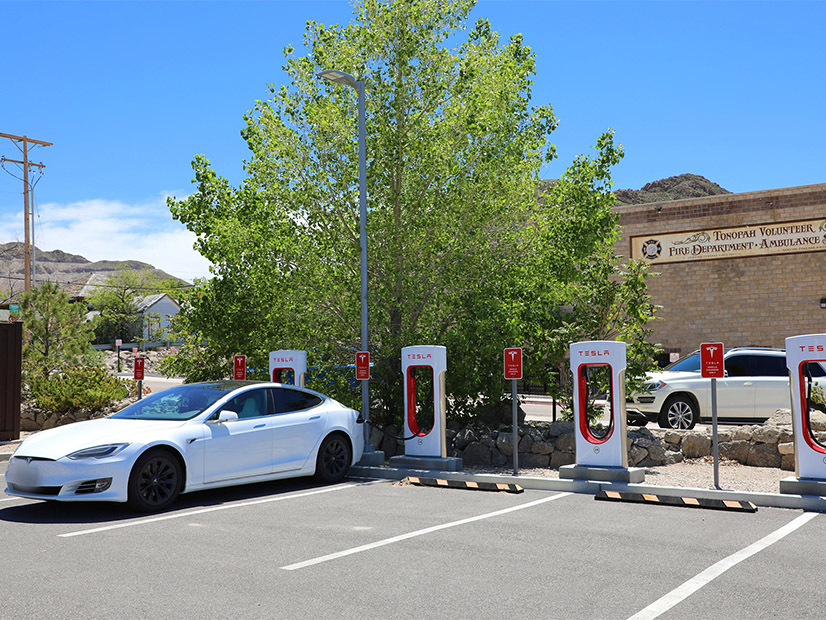
The Biden administration last week launched a $2.5 billion program to fund EV charging stations across the nation, but the state of Nevada doesn’t plan to apply.
Instead, the Nevada Department of Transportation will support applications from local governments and other entities that apply for the funding.
The new funding, through the U.S. Department of Transportation’s Charging and Fueling Infrastructure (CFI) discretionary grant program, is a complement to the federal National Electric Vehicle Infrastructure (NEVI) program. (See DOT Opens New Round of IIJA Funding for EV Chargers.)
All 50 states plus Puerto Rico and D.C. submitted NEVI plans last year, which the Federal Highway Administration approved in September. The goal is to create a national network of public EV charging stations. Nevada is receiving $38 million in NEVI funds.
“At this point, Nevada is looking to spend the NEVI funds. We are not looking to apply for discretionary grants,” said Kandee Bahr Worley, NDOT’s division chief for sustainability and emerging transportation. “We’re hoping that our MPOs, [metropolitan planning organizations] our cities, our counties and other entities would be reaching out for those funds for projects that they’re putting together.”
Bahr Worley said NDOT is willing to write letters of support for funding applicants, offer grant-writing assistance “and hopefully win those grants and bring that money into Nevada.”
Bahr Worley’s comments came during a Southwest Energy Efficiency Project (SWEEP) webinar last week on funding opportunities for EV infrastructure in Nevada.
Travis Madsen, SWEEP’s transportation program director, said that Nevada is one of the top 10 states when it comes to EV market share. Last year, nearly 10% of light-duty vehicle sales in Nevada were EVs. Close to 50,000 light-duty EVs will be on Nevada’s roads by the end of the year, he projected.
“Nevada is well on its way in the journey toward transportation electrification,” Madsen said.
Interstates, U.S. Highways
With the growing number of EVs comes the need for more public charging. Efforts to build a statewide charging network in Nevada got underway with the Nevada Electric Highway program, which funded about 30 EV charging stations.
The NEVI program will build on that work, and Bahr Worley gave an overview of Nevada’s NEVI progress. In the first year of funding, NDOT will focus on the state’s six interstates: I-15, I-80, I-11, I-580, I-215 and I-515.
Two new charging stations are planned — in Carson City and in either Jean or Primm along the I-15 corridor. Three other stations, in Moapa, Carlin and Wells, will be upgraded to meet NEVI standards. The program requires at least four charging ports per station with a power output of at least 15 kW each.
The second year will focus on U.S. highways 50, 395, 95 and 93. Those highways, along with the interstates, are designated alternative fuel corridors, which are the NEVI program’s priority.
In some cases, NDOT is requesting exceptions from NEVI program requirements to space charging stations 50 miles apart and locate them no more than a mile away from the highway. Bahr Worley noted that Nevada highways run through some unpopulated areas.
“Not only do we not have population, we do not have electricity at certain areas,” she said.
And NDOT is concentrating its efforts on areas outside of NV Energy territory. The utility, whose territory covers much of the state, has its own transportation electrification plans, mandated by Senate Bill 448 of 2021.
Nevada is also talking to Tesla about its plans, announced last month, to open some of its charging stalls to non-Tesla EVs.
One listener asked whether NEVI funds would be available for charging stations along state highways, some of which are heavily traveled.
Bahr Worley said that’s a possibility, if money is leftover after the charging network along U.S. highways and interstates is built out.
CFI Flexibility
The newly launched CFI discretionary grant program is another possible funding source for charging sites on state highways.
The program has two components. In the Corridor Program, funding is reserved for EV charging infrastructure along alternative fuel corridors, such as interstates and U.S. highways.
But the Community Program provides more flexibility, with funding available for EV charging stations on any public road, at public buildings or parks, or at publicly accessible parking facilities owned or managed by a private entity.
Entities that are eligible to apply include states, local governments, MPOs, special districts or authorities with a transportation function, public and state colleges and universities, and tribal governments.
In the first round of CFI funding, $700 million will be available. The application deadline is May 30. A webinar on March 22 will cover more details.
Both the NEVI and CFI programs were established through the Infrastructure Investment and Jobs Act (IIJA). Other programs expanded under IIJA also offer funding for EV charging, infrastructure planning and workforce development.
To help sort out the various federal funding options, the Electrification Coalition has developed a tool called the EV Funding Finder.
Webinar speaker Will Drier, a policy manager with the Electrification Coalition, said the tool includes information such as matching-fund requirements and whether money from different funds can be combined or “stacked.”
The tool includes case studies on different transportation electrification scenarios, such as a city that plans to electrify its fleet.
More information on the EV Funding Finder is available here.
